Strategic Resource Allocation and Planning: Harley-Davidson Case
VerifiedAdded on 2023/06/15
|13
|2092
|237
Case Study
AI Summary
This case study provides a strategic analysis of Harley-Davidson, focusing on long-term strategic planning. It examines general environmental factors (technological, demographic, economic, political/legal, sociocultural, global, and physical), industry analysis, and competitor analysis. The report includes a SWOT analysis identifying Harley-Davidson's strengths, weaknesses, opportunities, and threats. It formulates a strategy for product extension, specifically suggesting the introduction of cycles under the Harley-Davidson brand. A strategic action plan outlines steps for market research, dealer tie-ups, customer needs identification, manufacturing decisions, and product launch. The analysis concludes with recommendations for expanding the business internationally to achieve sustainable growth. Desklib provides access to similar case studies and resources for students.

Strategic Resource Allocation and
Planning
Planning
Paraphrase This Document
Need a fresh take? Get an instant paraphrase of this document with our AI Paraphraser
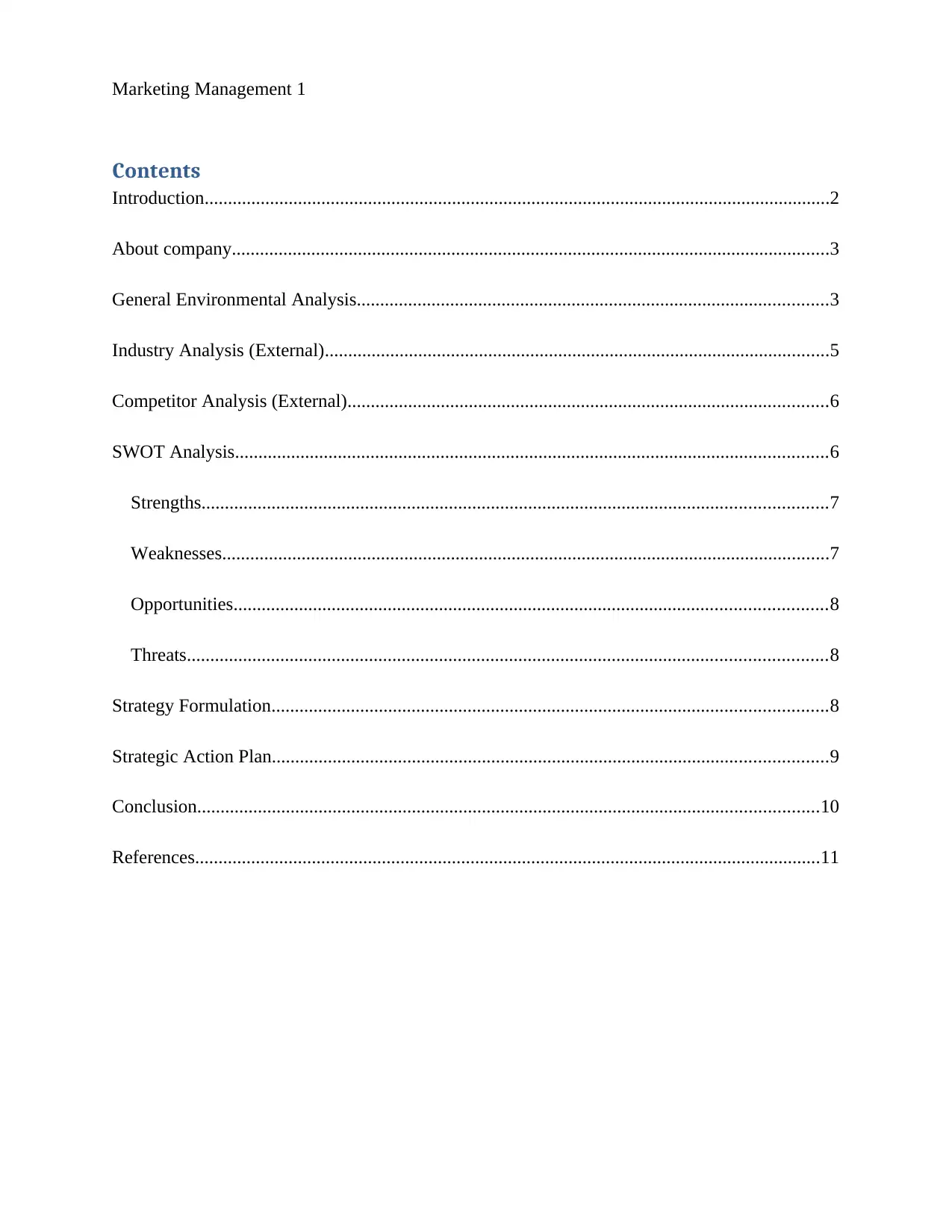
Marketing Management 1
Contents
Introduction......................................................................................................................................2
About company................................................................................................................................3
General Environmental Analysis.....................................................................................................3
Industry Analysis (External)............................................................................................................5
Competitor Analysis (External).......................................................................................................6
SWOT Analysis...............................................................................................................................6
Strengths......................................................................................................................................7
Weaknesses..................................................................................................................................7
Opportunities...............................................................................................................................8
Threats.........................................................................................................................................8
Strategy Formulation.......................................................................................................................8
Strategic Action Plan.......................................................................................................................9
Conclusion.....................................................................................................................................10
References......................................................................................................................................11
Contents
Introduction......................................................................................................................................2
About company................................................................................................................................3
General Environmental Analysis.....................................................................................................3
Industry Analysis (External)............................................................................................................5
Competitor Analysis (External).......................................................................................................6
SWOT Analysis...............................................................................................................................6
Strengths......................................................................................................................................7
Weaknesses..................................................................................................................................7
Opportunities...............................................................................................................................8
Threats.........................................................................................................................................8
Strategy Formulation.......................................................................................................................8
Strategic Action Plan.......................................................................................................................9
Conclusion.....................................................................................................................................10
References......................................................................................................................................11
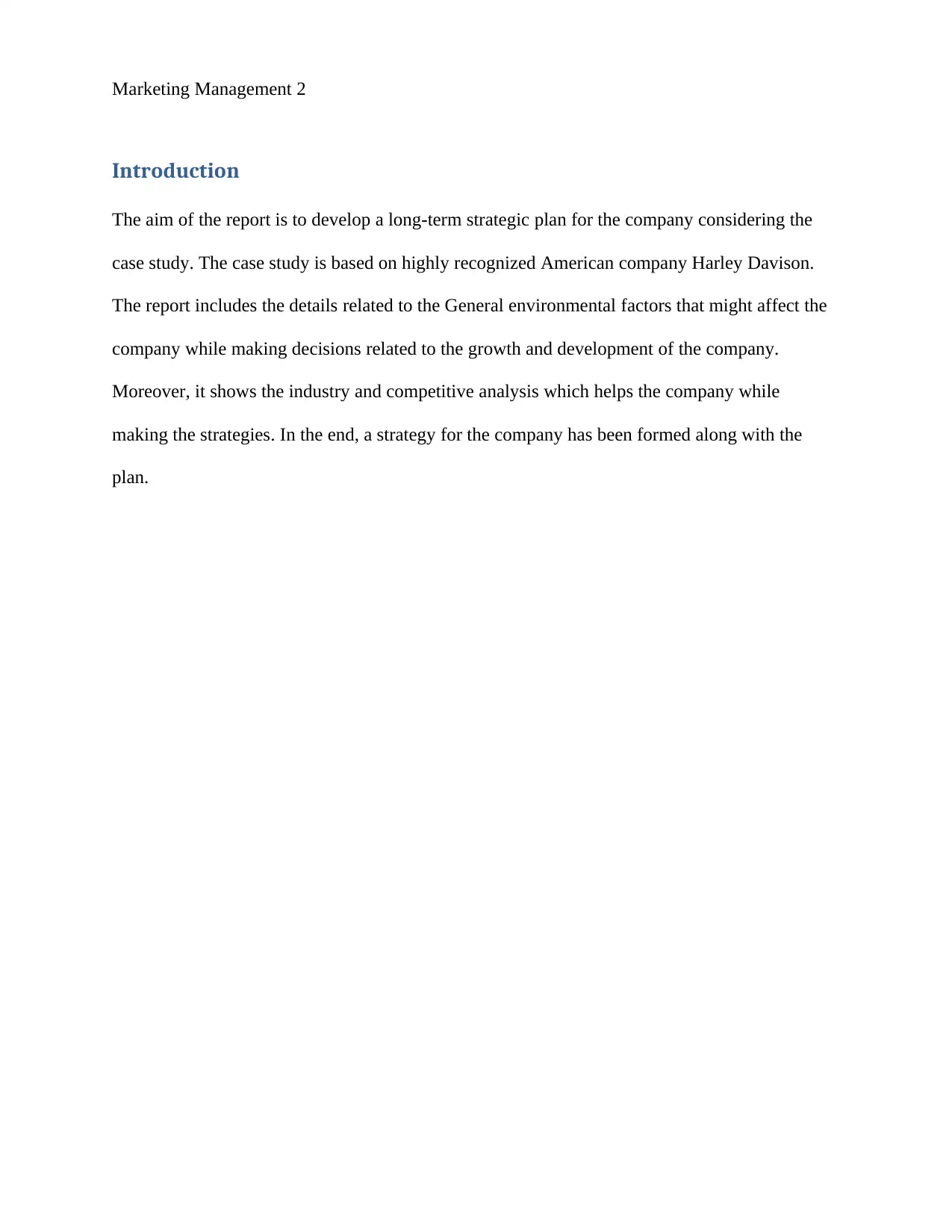
Marketing Management 2
Introduction
The aim of the report is to develop a long-term strategic plan for the company considering the
case study. The case study is based on highly recognized American company Harley Davison.
The report includes the details related to the General environmental factors that might affect the
company while making decisions related to the growth and development of the company.
Moreover, it shows the industry and competitive analysis which helps the company while
making the strategies. In the end, a strategy for the company has been formed along with the
plan.
Introduction
The aim of the report is to develop a long-term strategic plan for the company considering the
case study. The case study is based on highly recognized American company Harley Davison.
The report includes the details related to the General environmental factors that might affect the
company while making decisions related to the growth and development of the company.
Moreover, it shows the industry and competitive analysis which helps the company while
making the strategies. In the end, a strategy for the company has been formed along with the
plan.
⊘ This is a preview!⊘
Do you want full access?
Subscribe today to unlock all pages.

Trusted by 1+ million students worldwide
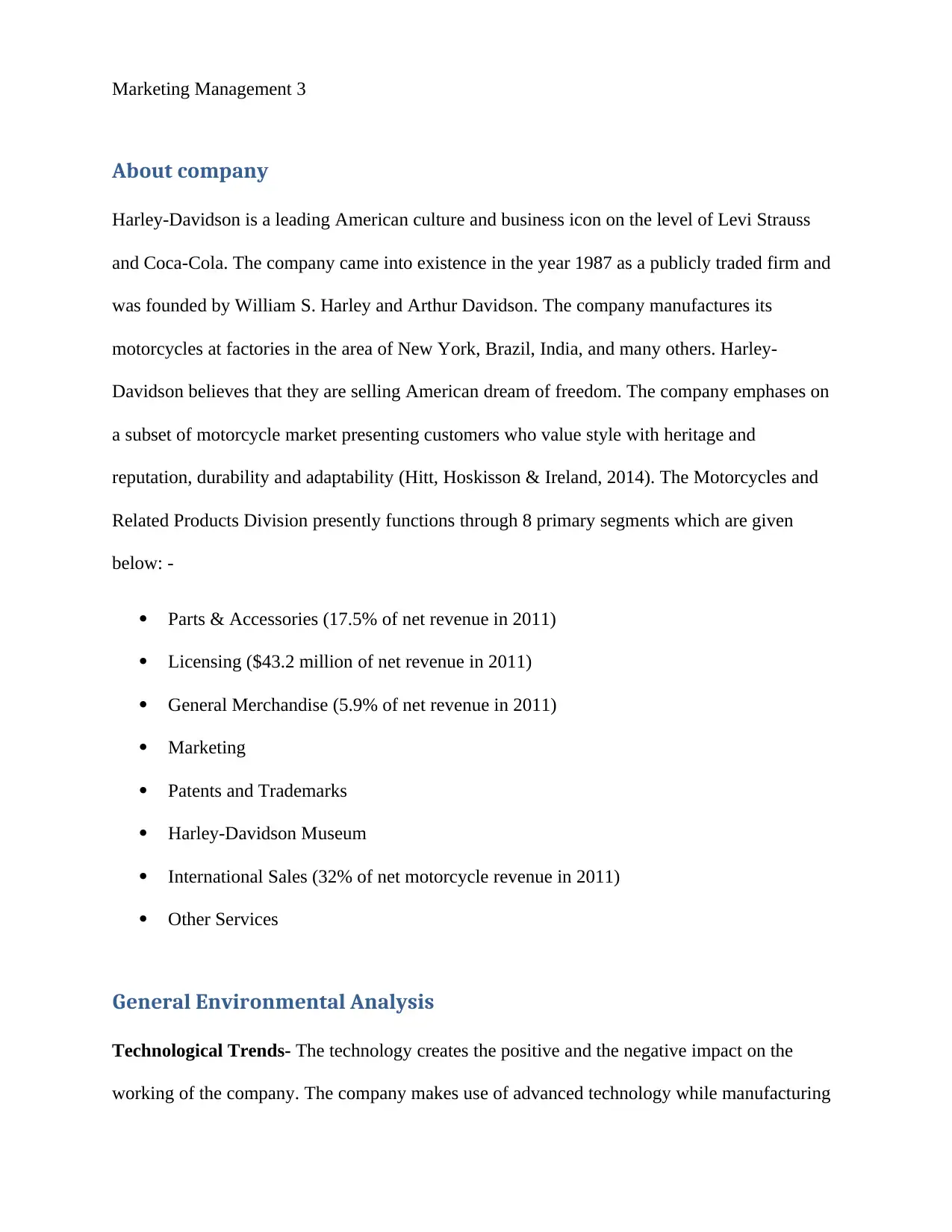
Marketing Management 3
About company
Harley-Davidson is a leading American culture and business icon on the level of Levi Strauss
and Coca-Cola. The company came into existence in the year 1987 as a publicly traded firm and
was founded by William S. Harley and Arthur Davidson. The company manufactures its
motorcycles at factories in the area of New York, Brazil, India, and many others. Harley-
Davidson believes that they are selling American dream of freedom. The company emphases on
a subset of motorcycle market presenting customers who value style with heritage and
reputation, durability and adaptability (Hitt, Hoskisson & Ireland, 2014). The Motorcycles and
Related Products Division presently functions through 8 primary segments which are given
below: -
Parts & Accessories (17.5% of net revenue in 2011)
Licensing ($43.2 million of net revenue in 2011)
General Merchandise (5.9% of net revenue in 2011)
Marketing
Patents and Trademarks
Harley-Davidson Museum
International Sales (32% of net motorcycle revenue in 2011)
Other Services
General Environmental Analysis
Technological Trends- The technology creates the positive and the negative impact on the
working of the company. The company makes use of advanced technology while manufacturing
About company
Harley-Davidson is a leading American culture and business icon on the level of Levi Strauss
and Coca-Cola. The company came into existence in the year 1987 as a publicly traded firm and
was founded by William S. Harley and Arthur Davidson. The company manufactures its
motorcycles at factories in the area of New York, Brazil, India, and many others. Harley-
Davidson believes that they are selling American dream of freedom. The company emphases on
a subset of motorcycle market presenting customers who value style with heritage and
reputation, durability and adaptability (Hitt, Hoskisson & Ireland, 2014). The Motorcycles and
Related Products Division presently functions through 8 primary segments which are given
below: -
Parts & Accessories (17.5% of net revenue in 2011)
Licensing ($43.2 million of net revenue in 2011)
General Merchandise (5.9% of net revenue in 2011)
Marketing
Patents and Trademarks
Harley-Davidson Museum
International Sales (32% of net motorcycle revenue in 2011)
Other Services
General Environmental Analysis
Technological Trends- The technology creates the positive and the negative impact on the
working of the company. The company makes use of advanced technology while manufacturing
Paraphrase This Document
Need a fresh take? Get an instant paraphrase of this document with our AI Paraphraser
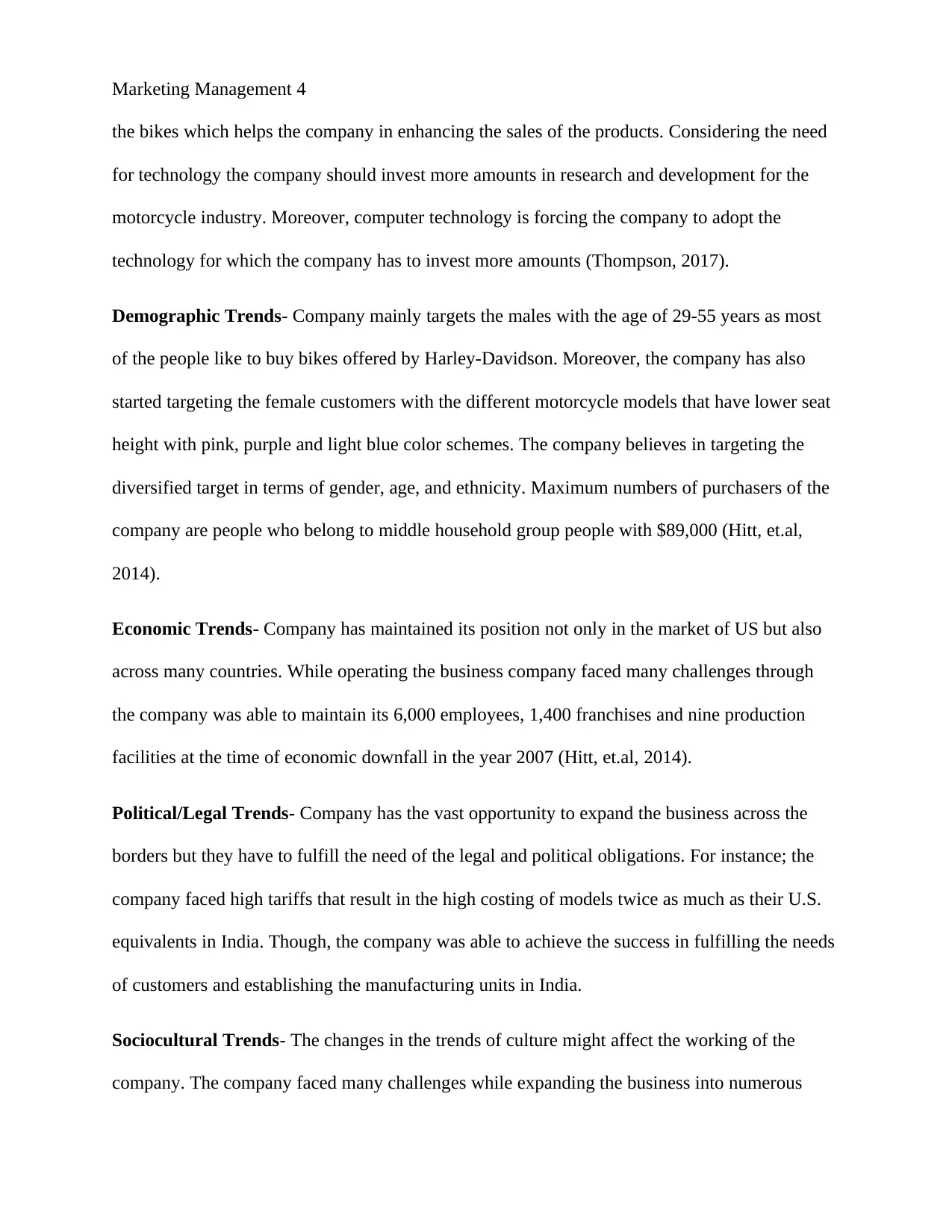
Marketing Management 4
the bikes which helps the company in enhancing the sales of the products. Considering the need
for technology the company should invest more amounts in research and development for the
motorcycle industry. Moreover, computer technology is forcing the company to adopt the
technology for which the company has to invest more amounts (Thompson, 2017).
Demographic Trends- Company mainly targets the males with the age of 29-55 years as most
of the people like to buy bikes offered by Harley-Davidson. Moreover, the company has also
started targeting the female customers with the different motorcycle models that have lower seat
height with pink, purple and light blue color schemes. The company believes in targeting the
diversified target in terms of gender, age, and ethnicity. Maximum numbers of purchasers of the
company are people who belong to middle household group people with $89,000 (Hitt, et.al,
2014).
Economic Trends- Company has maintained its position not only in the market of US but also
across many countries. While operating the business company faced many challenges through
the company was able to maintain its 6,000 employees, 1,400 franchises and nine production
facilities at the time of economic downfall in the year 2007 (Hitt, et.al, 2014).
Political/Legal Trends- Company has the vast opportunity to expand the business across the
borders but they have to fulfill the need of the legal and political obligations. For instance; the
company faced high tariffs that result in the high costing of models twice as much as their U.S.
equivalents in India. Though, the company was able to achieve the success in fulfilling the needs
of customers and establishing the manufacturing units in India.
Sociocultural Trends- The changes in the trends of culture might affect the working of the
company. The company faced many challenges while expanding the business into numerous
the bikes which helps the company in enhancing the sales of the products. Considering the need
for technology the company should invest more amounts in research and development for the
motorcycle industry. Moreover, computer technology is forcing the company to adopt the
technology for which the company has to invest more amounts (Thompson, 2017).
Demographic Trends- Company mainly targets the males with the age of 29-55 years as most
of the people like to buy bikes offered by Harley-Davidson. Moreover, the company has also
started targeting the female customers with the different motorcycle models that have lower seat
height with pink, purple and light blue color schemes. The company believes in targeting the
diversified target in terms of gender, age, and ethnicity. Maximum numbers of purchasers of the
company are people who belong to middle household group people with $89,000 (Hitt, et.al,
2014).
Economic Trends- Company has maintained its position not only in the market of US but also
across many countries. While operating the business company faced many challenges through
the company was able to maintain its 6,000 employees, 1,400 franchises and nine production
facilities at the time of economic downfall in the year 2007 (Hitt, et.al, 2014).
Political/Legal Trends- Company has the vast opportunity to expand the business across the
borders but they have to fulfill the need of the legal and political obligations. For instance; the
company faced high tariffs that result in the high costing of models twice as much as their U.S.
equivalents in India. Though, the company was able to achieve the success in fulfilling the needs
of customers and establishing the manufacturing units in India.
Sociocultural Trends- The changes in the trends of culture might affect the working of the
company. The company faced many challenges while expanding the business into numerous
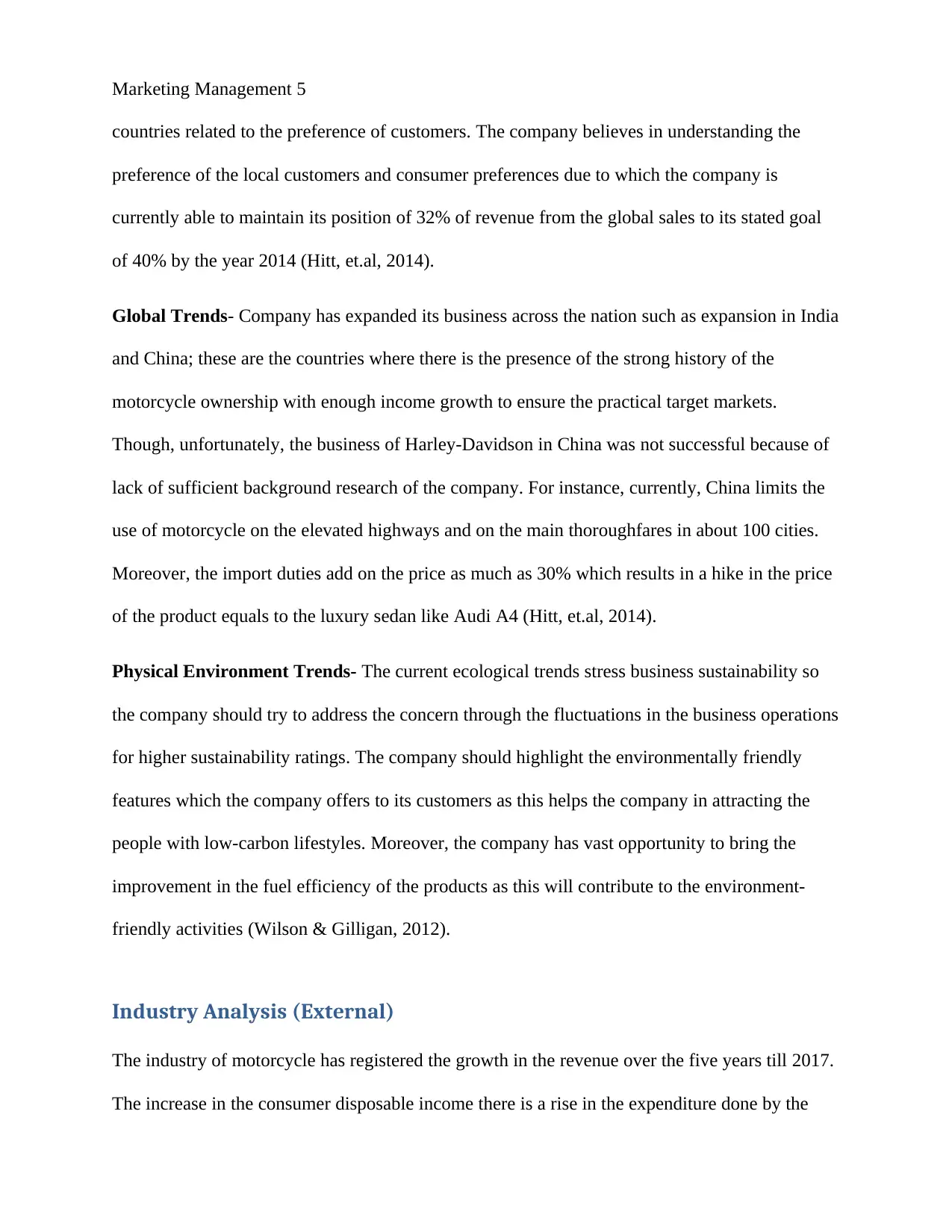
Marketing Management 5
countries related to the preference of customers. The company believes in understanding the
preference of the local customers and consumer preferences due to which the company is
currently able to maintain its position of 32% of revenue from the global sales to its stated goal
of 40% by the year 2014 (Hitt, et.al, 2014).
Global Trends- Company has expanded its business across the nation such as expansion in India
and China; these are the countries where there is the presence of the strong history of the
motorcycle ownership with enough income growth to ensure the practical target markets.
Though, unfortunately, the business of Harley-Davidson in China was not successful because of
lack of sufficient background research of the company. For instance, currently, China limits the
use of motorcycle on the elevated highways and on the main thoroughfares in about 100 cities.
Moreover, the import duties add on the price as much as 30% which results in a hike in the price
of the product equals to the luxury sedan like Audi A4 (Hitt, et.al, 2014).
Physical Environment Trends- The current ecological trends stress business sustainability so
the company should try to address the concern through the fluctuations in the business operations
for higher sustainability ratings. The company should highlight the environmentally friendly
features which the company offers to its customers as this helps the company in attracting the
people with low-carbon lifestyles. Moreover, the company has vast opportunity to bring the
improvement in the fuel efficiency of the products as this will contribute to the environment-
friendly activities (Wilson & Gilligan, 2012).
Industry Analysis (External)
The industry of motorcycle has registered the growth in the revenue over the five years till 2017.
The increase in the consumer disposable income there is a rise in the expenditure done by the
countries related to the preference of customers. The company believes in understanding the
preference of the local customers and consumer preferences due to which the company is
currently able to maintain its position of 32% of revenue from the global sales to its stated goal
of 40% by the year 2014 (Hitt, et.al, 2014).
Global Trends- Company has expanded its business across the nation such as expansion in India
and China; these are the countries where there is the presence of the strong history of the
motorcycle ownership with enough income growth to ensure the practical target markets.
Though, unfortunately, the business of Harley-Davidson in China was not successful because of
lack of sufficient background research of the company. For instance, currently, China limits the
use of motorcycle on the elevated highways and on the main thoroughfares in about 100 cities.
Moreover, the import duties add on the price as much as 30% which results in a hike in the price
of the product equals to the luxury sedan like Audi A4 (Hitt, et.al, 2014).
Physical Environment Trends- The current ecological trends stress business sustainability so
the company should try to address the concern through the fluctuations in the business operations
for higher sustainability ratings. The company should highlight the environmentally friendly
features which the company offers to its customers as this helps the company in attracting the
people with low-carbon lifestyles. Moreover, the company has vast opportunity to bring the
improvement in the fuel efficiency of the products as this will contribute to the environment-
friendly activities (Wilson & Gilligan, 2012).
Industry Analysis (External)
The industry of motorcycle has registered the growth in the revenue over the five years till 2017.
The increase in the consumer disposable income there is a rise in the expenditure done by the
⊘ This is a preview!⊘
Do you want full access?
Subscribe today to unlock all pages.

Trusted by 1+ million students worldwide
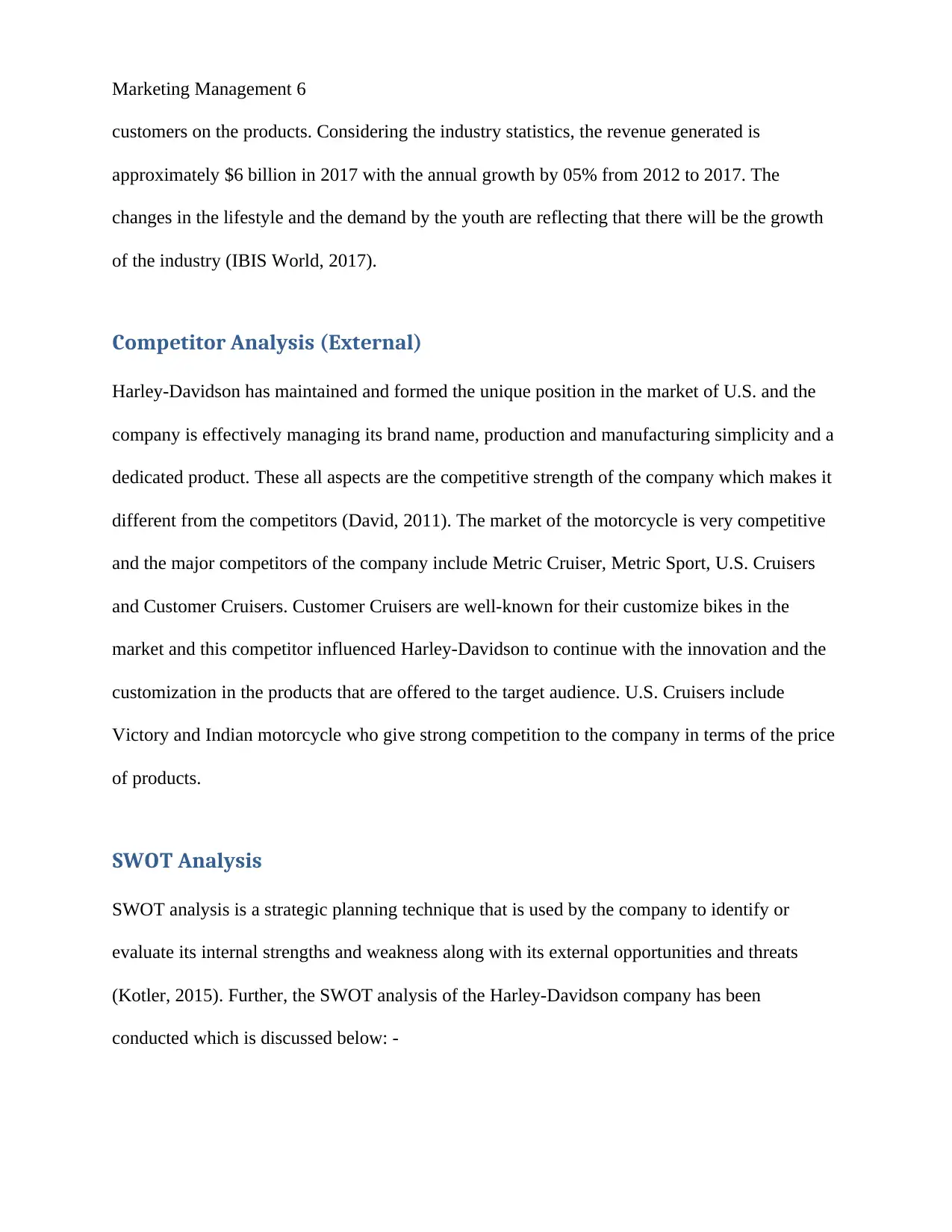
Marketing Management 6
customers on the products. Considering the industry statistics, the revenue generated is
approximately $6 billion in 2017 with the annual growth by 05% from 2012 to 2017. The
changes in the lifestyle and the demand by the youth are reflecting that there will be the growth
of the industry (IBIS World, 2017).
Competitor Analysis (External)
Harley-Davidson has maintained and formed the unique position in the market of U.S. and the
company is effectively managing its brand name, production and manufacturing simplicity and a
dedicated product. These all aspects are the competitive strength of the company which makes it
different from the competitors (David, 2011). The market of the motorcycle is very competitive
and the major competitors of the company include Metric Cruiser, Metric Sport, U.S. Cruisers
and Customer Cruisers. Customer Cruisers are well-known for their customize bikes in the
market and this competitor influenced Harley-Davidson to continue with the innovation and the
customization in the products that are offered to the target audience. U.S. Cruisers include
Victory and Indian motorcycle who give strong competition to the company in terms of the price
of products.
SWOT Analysis
SWOT analysis is a strategic planning technique that is used by the company to identify or
evaluate its internal strengths and weakness along with its external opportunities and threats
(Kotler, 2015). Further, the SWOT analysis of the Harley-Davidson company has been
conducted which is discussed below: -
customers on the products. Considering the industry statistics, the revenue generated is
approximately $6 billion in 2017 with the annual growth by 05% from 2012 to 2017. The
changes in the lifestyle and the demand by the youth are reflecting that there will be the growth
of the industry (IBIS World, 2017).
Competitor Analysis (External)
Harley-Davidson has maintained and formed the unique position in the market of U.S. and the
company is effectively managing its brand name, production and manufacturing simplicity and a
dedicated product. These all aspects are the competitive strength of the company which makes it
different from the competitors (David, 2011). The market of the motorcycle is very competitive
and the major competitors of the company include Metric Cruiser, Metric Sport, U.S. Cruisers
and Customer Cruisers. Customer Cruisers are well-known for their customize bikes in the
market and this competitor influenced Harley-Davidson to continue with the innovation and the
customization in the products that are offered to the target audience. U.S. Cruisers include
Victory and Indian motorcycle who give strong competition to the company in terms of the price
of products.
SWOT Analysis
SWOT analysis is a strategic planning technique that is used by the company to identify or
evaluate its internal strengths and weakness along with its external opportunities and threats
(Kotler, 2015). Further, the SWOT analysis of the Harley-Davidson company has been
conducted which is discussed below: -
Paraphrase This Document
Need a fresh take? Get an instant paraphrase of this document with our AI Paraphraser
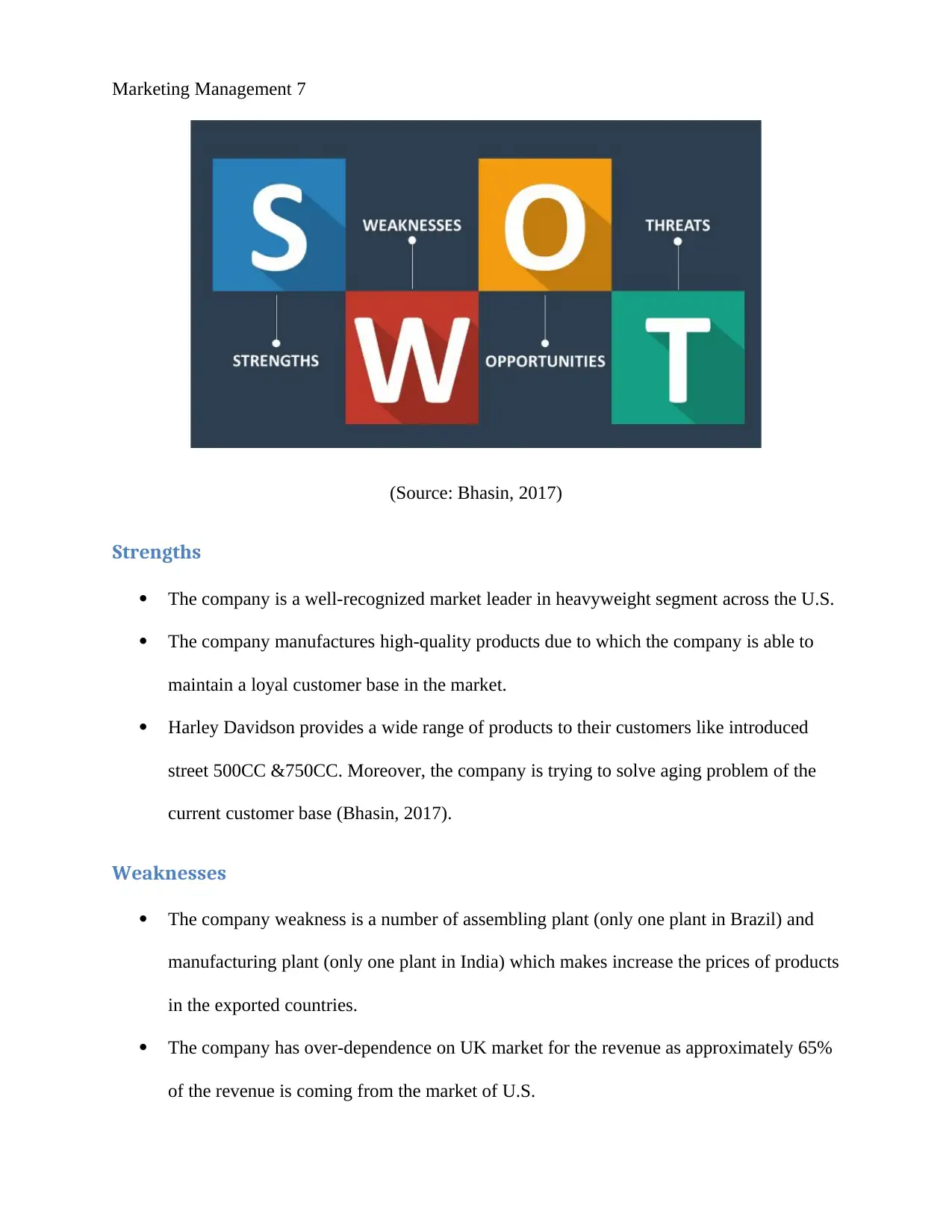
Marketing Management 7
(Source: Bhasin, 2017)
Strengths
The company is a well-recognized market leader in heavyweight segment across the U.S.
The company manufactures high-quality products due to which the company is able to
maintain a loyal customer base in the market.
Harley Davidson provides a wide range of products to their customers like introduced
street 500CC &750CC. Moreover, the company is trying to solve aging problem of the
current customer base (Bhasin, 2017).
Weaknesses
The company weakness is a number of assembling plant (only one plant in Brazil) and
manufacturing plant (only one plant in India) which makes increase the prices of products
in the exported countries.
The company has over-dependence on UK market for the revenue as approximately 65%
of the revenue is coming from the market of U.S.
(Source: Bhasin, 2017)
Strengths
The company is a well-recognized market leader in heavyweight segment across the U.S.
The company manufactures high-quality products due to which the company is able to
maintain a loyal customer base in the market.
Harley Davidson provides a wide range of products to their customers like introduced
street 500CC &750CC. Moreover, the company is trying to solve aging problem of the
current customer base (Bhasin, 2017).
Weaknesses
The company weakness is a number of assembling plant (only one plant in Brazil) and
manufacturing plant (only one plant in India) which makes increase the prices of products
in the exported countries.
The company has over-dependence on UK market for the revenue as approximately 65%
of the revenue is coming from the market of U.S.
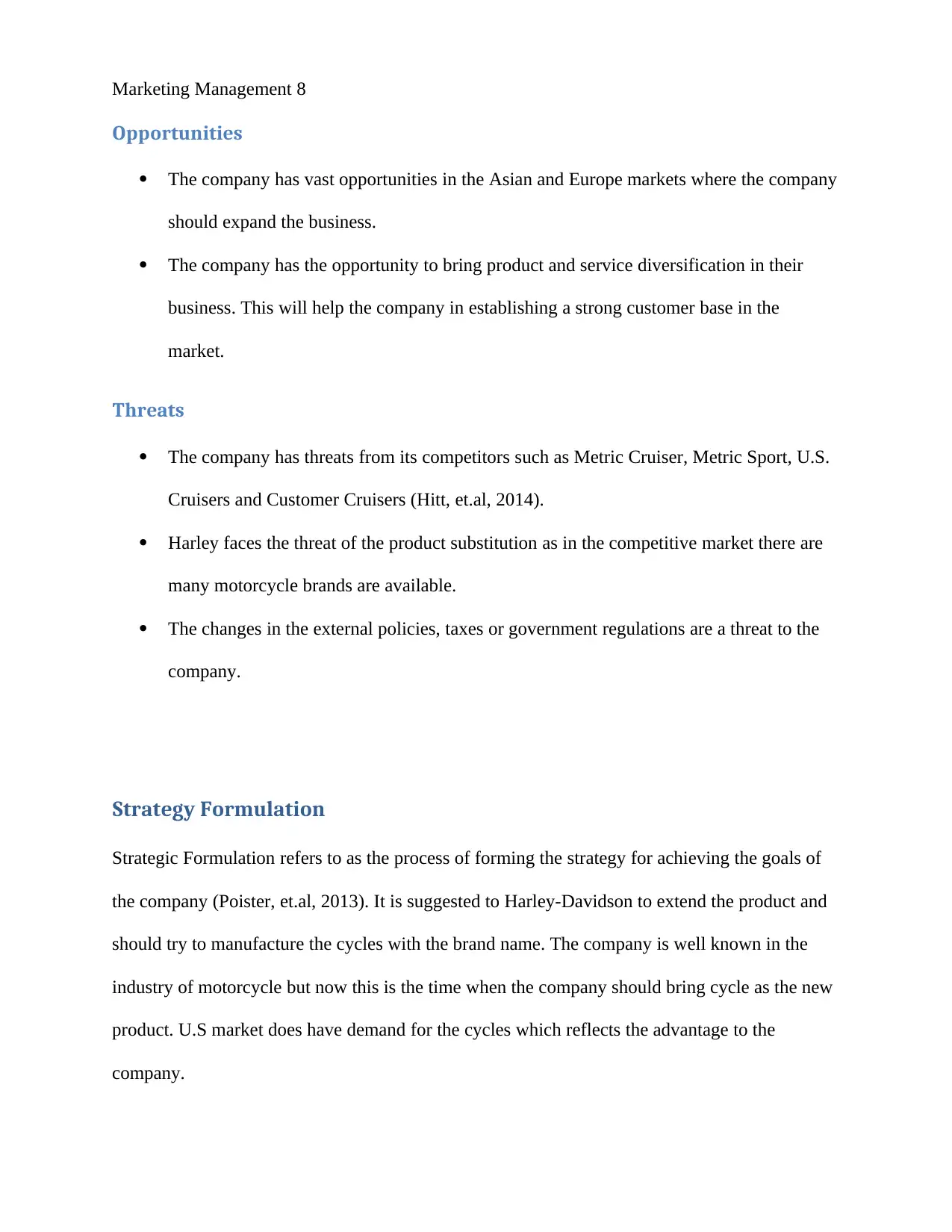
Marketing Management 8
Opportunities
The company has vast opportunities in the Asian and Europe markets where the company
should expand the business.
The company has the opportunity to bring product and service diversification in their
business. This will help the company in establishing a strong customer base in the
market.
Threats
The company has threats from its competitors such as Metric Cruiser, Metric Sport, U.S.
Cruisers and Customer Cruisers (Hitt, et.al, 2014).
Harley faces the threat of the product substitution as in the competitive market there are
many motorcycle brands are available.
The changes in the external policies, taxes or government regulations are a threat to the
company.
Strategy Formulation
Strategic Formulation refers to as the process of forming the strategy for achieving the goals of
the company (Poister, et.al, 2013). It is suggested to Harley-Davidson to extend the product and
should try to manufacture the cycles with the brand name. The company is well known in the
industry of motorcycle but now this is the time when the company should bring cycle as the new
product. U.S market does have demand for the cycles which reflects the advantage to the
company.
Opportunities
The company has vast opportunities in the Asian and Europe markets where the company
should expand the business.
The company has the opportunity to bring product and service diversification in their
business. This will help the company in establishing a strong customer base in the
market.
Threats
The company has threats from its competitors such as Metric Cruiser, Metric Sport, U.S.
Cruisers and Customer Cruisers (Hitt, et.al, 2014).
Harley faces the threat of the product substitution as in the competitive market there are
many motorcycle brands are available.
The changes in the external policies, taxes or government regulations are a threat to the
company.
Strategy Formulation
Strategic Formulation refers to as the process of forming the strategy for achieving the goals of
the company (Poister, et.al, 2013). It is suggested to Harley-Davidson to extend the product and
should try to manufacture the cycles with the brand name. The company is well known in the
industry of motorcycle but now this is the time when the company should bring cycle as the new
product. U.S market does have demand for the cycles which reflects the advantage to the
company.
⊘ This is a preview!⊘
Do you want full access?
Subscribe today to unlock all pages.

Trusted by 1+ million students worldwide
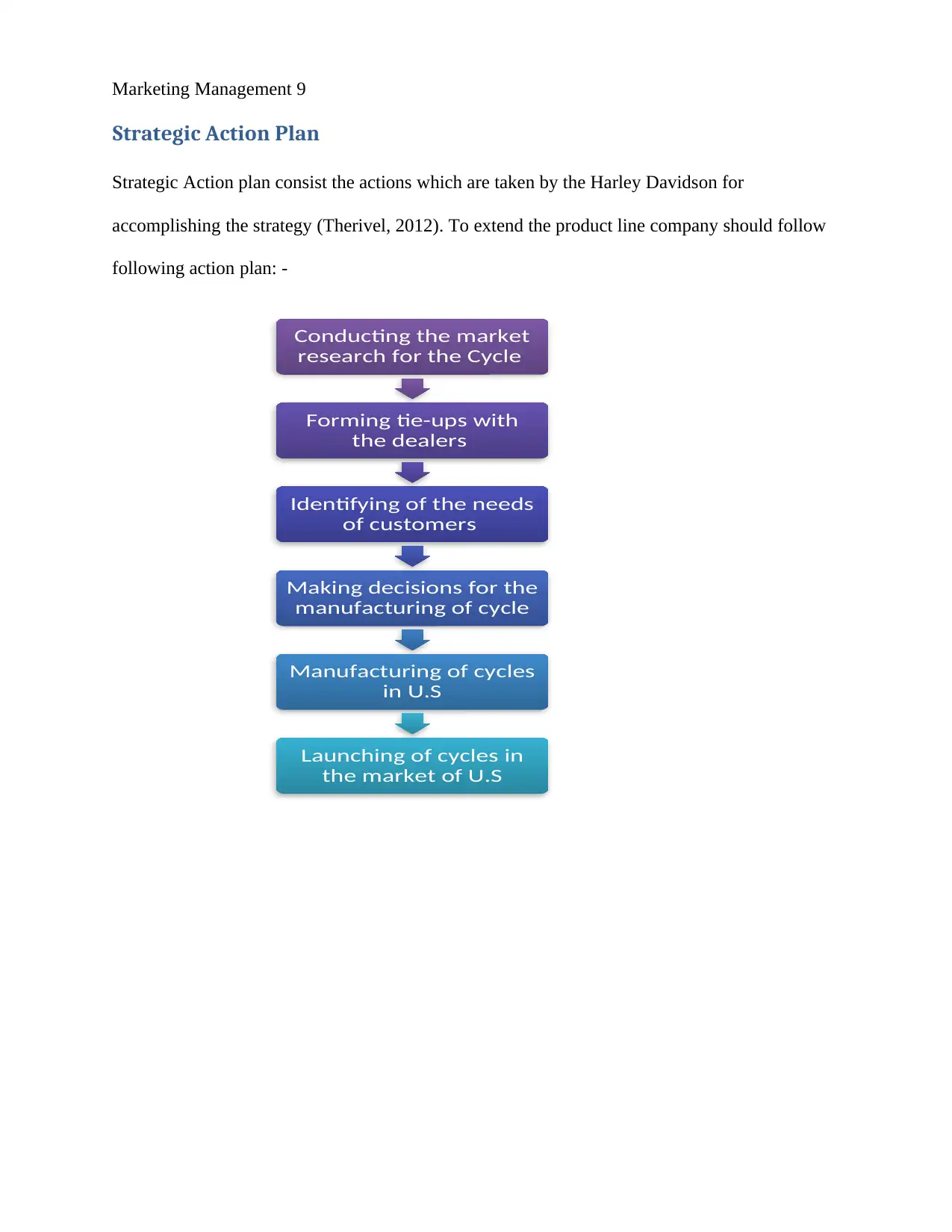
Marketing Management 9
Strategic Action Plan
Strategic Action plan consist the actions which are taken by the Harley Davidson for
accomplishing the strategy (Therivel, 2012). To extend the product line company should follow
following action plan: -
Conducting the market
research for the Cycle
Forming tie-ups with
the dealers
Identifying of the needs
of customers
Making decisions for the
manufacturing of cycle
Manufacturing of cycles
in U.S
Launching of cycles in
the market of U.S
Strategic Action Plan
Strategic Action plan consist the actions which are taken by the Harley Davidson for
accomplishing the strategy (Therivel, 2012). To extend the product line company should follow
following action plan: -
Conducting the market
research for the Cycle
Forming tie-ups with
the dealers
Identifying of the needs
of customers
Making decisions for the
manufacturing of cycle
Manufacturing of cycles
in U.S
Launching of cycles in
the market of U.S
Paraphrase This Document
Need a fresh take? Get an instant paraphrase of this document with our AI Paraphraser
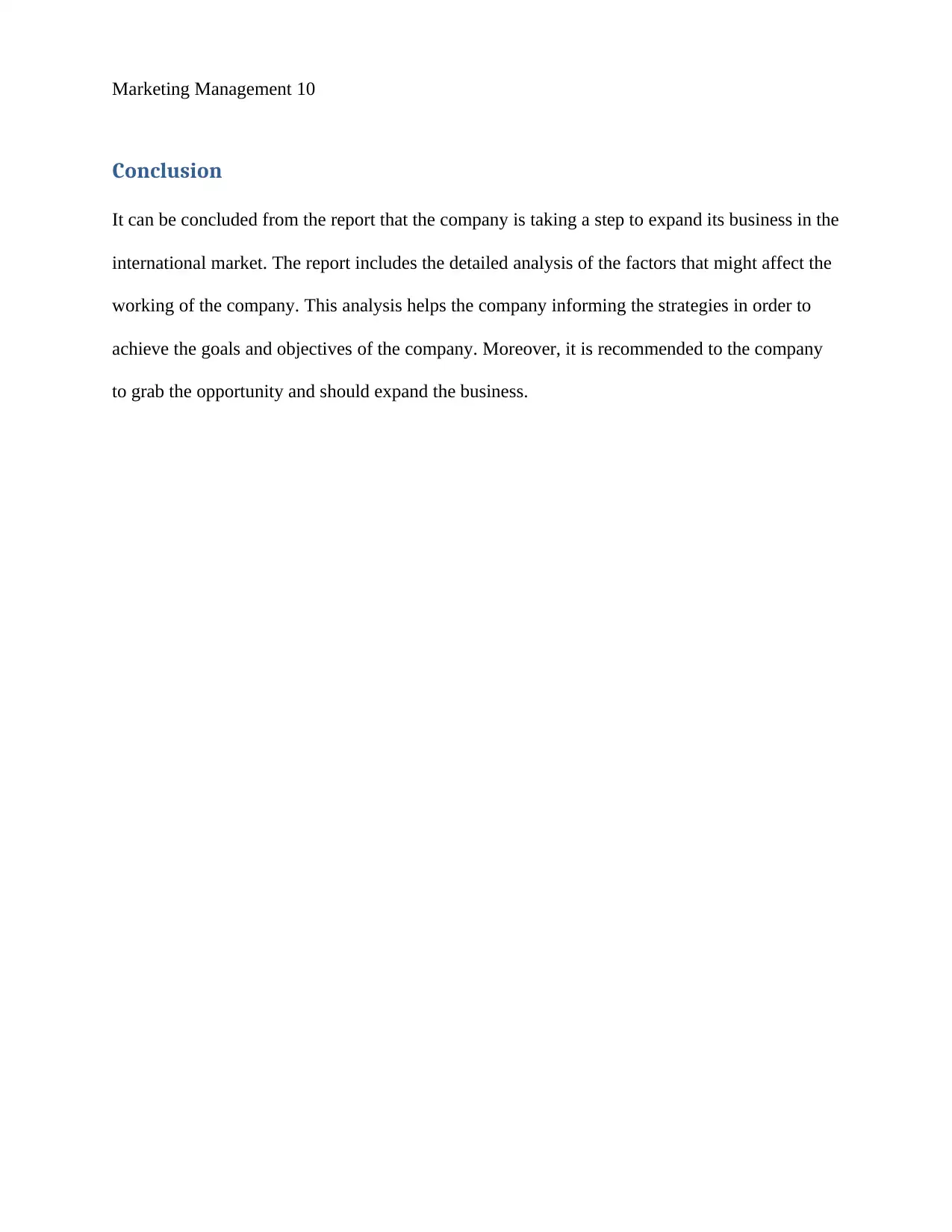
Marketing Management 10
Conclusion
It can be concluded from the report that the company is taking a step to expand its business in the
international market. The report includes the detailed analysis of the factors that might affect the
working of the company. This analysis helps the company informing the strategies in order to
achieve the goals and objectives of the company. Moreover, it is recommended to the company
to grab the opportunity and should expand the business.
Conclusion
It can be concluded from the report that the company is taking a step to expand its business in the
international market. The report includes the detailed analysis of the factors that might affect the
working of the company. This analysis helps the company informing the strategies in order to
achieve the goals and objectives of the company. Moreover, it is recommended to the company
to grab the opportunity and should expand the business.
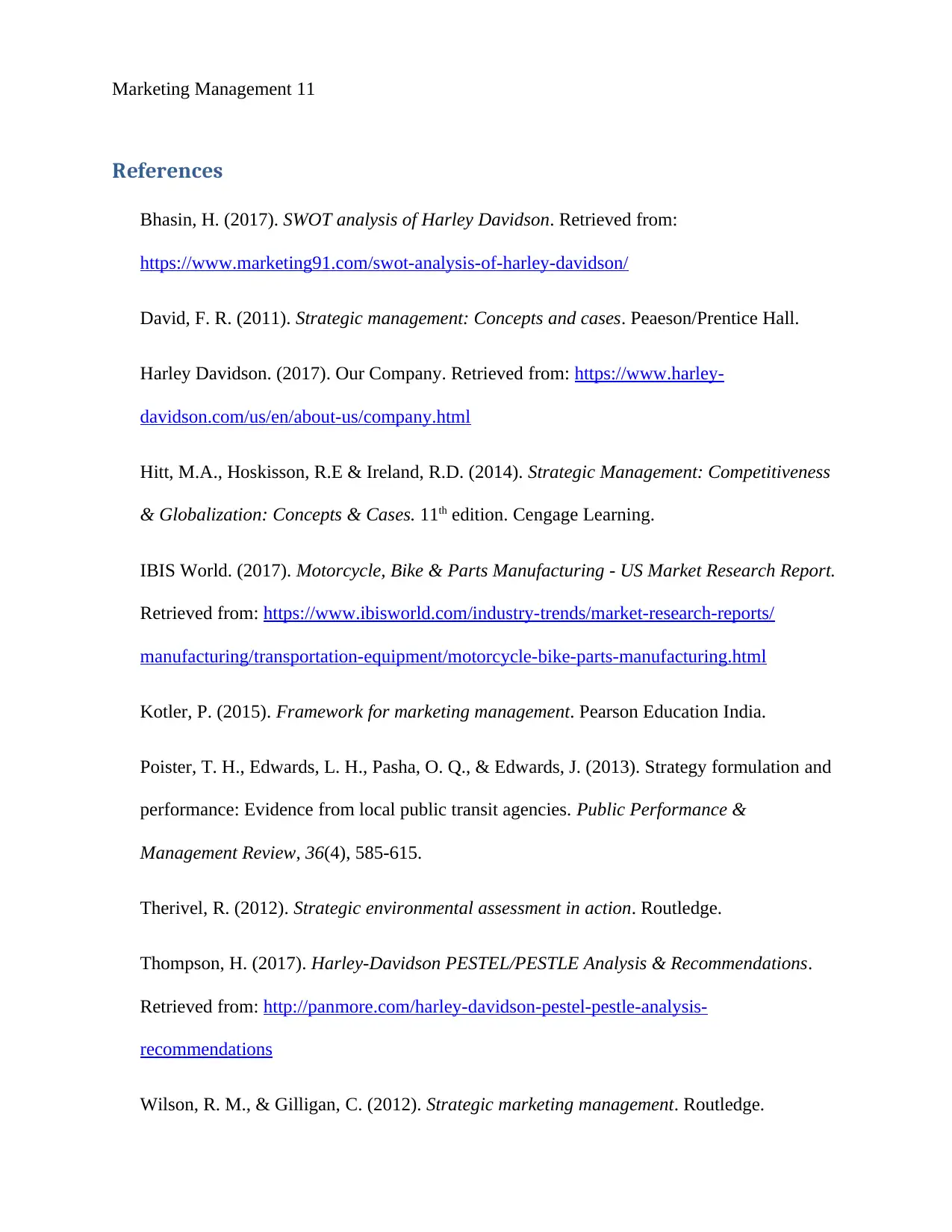
Marketing Management 11
References
Bhasin, H. (2017). SWOT analysis of Harley Davidson. Retrieved from:
https://www.marketing91.com/swot-analysis-of-harley-davidson/
David, F. R. (2011). Strategic management: Concepts and cases. Peaeson/Prentice Hall.
Harley Davidson. (2017). Our Company. Retrieved from: https://www.harley-
davidson.com/us/en/about-us/company.html
Hitt, M.A., Hoskisson, R.E & Ireland, R.D. (2014). Strategic Management: Competitiveness
& Globalization: Concepts & Cases. 11th edition. Cengage Learning.
IBIS World. (2017). Motorcycle, Bike & Parts Manufacturing - US Market Research Report.
Retrieved from: https://www.ibisworld.com/industry-trends/market-research-reports/
manufacturing/transportation-equipment/motorcycle-bike-parts-manufacturing.html
Kotler, P. (2015). Framework for marketing management. Pearson Education India.
Poister, T. H., Edwards, L. H., Pasha, O. Q., & Edwards, J. (2013). Strategy formulation and
performance: Evidence from local public transit agencies. Public Performance &
Management Review, 36(4), 585-615.
Therivel, R. (2012). Strategic environmental assessment in action. Routledge.
Thompson, H. (2017). Harley-Davidson PESTEL/PESTLE Analysis & Recommendations.
Retrieved from: http://panmore.com/harley-davidson-pestel-pestle-analysis-
recommendations
Wilson, R. M., & Gilligan, C. (2012). Strategic marketing management. Routledge.
References
Bhasin, H. (2017). SWOT analysis of Harley Davidson. Retrieved from:
https://www.marketing91.com/swot-analysis-of-harley-davidson/
David, F. R. (2011). Strategic management: Concepts and cases. Peaeson/Prentice Hall.
Harley Davidson. (2017). Our Company. Retrieved from: https://www.harley-
davidson.com/us/en/about-us/company.html
Hitt, M.A., Hoskisson, R.E & Ireland, R.D. (2014). Strategic Management: Competitiveness
& Globalization: Concepts & Cases. 11th edition. Cengage Learning.
IBIS World. (2017). Motorcycle, Bike & Parts Manufacturing - US Market Research Report.
Retrieved from: https://www.ibisworld.com/industry-trends/market-research-reports/
manufacturing/transportation-equipment/motorcycle-bike-parts-manufacturing.html
Kotler, P. (2015). Framework for marketing management. Pearson Education India.
Poister, T. H., Edwards, L. H., Pasha, O. Q., & Edwards, J. (2013). Strategy formulation and
performance: Evidence from local public transit agencies. Public Performance &
Management Review, 36(4), 585-615.
Therivel, R. (2012). Strategic environmental assessment in action. Routledge.
Thompson, H. (2017). Harley-Davidson PESTEL/PESTLE Analysis & Recommendations.
Retrieved from: http://panmore.com/harley-davidson-pestel-pestle-analysis-
recommendations
Wilson, R. M., & Gilligan, C. (2012). Strategic marketing management. Routledge.
⊘ This is a preview!⊘
Do you want full access?
Subscribe today to unlock all pages.

Trusted by 1+ million students worldwide
1 out of 13
Related Documents
Your All-in-One AI-Powered Toolkit for Academic Success.
+13062052269
info@desklib.com
Available 24*7 on WhatsApp / Email
![[object Object]](/_next/static/media/star-bottom.7253800d.svg)
Unlock your academic potential
Copyright © 2020–2025 A2Z Services. All Rights Reserved. Developed and managed by ZUCOL.




